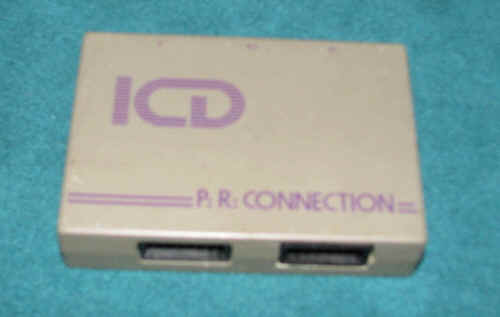 PRC
Review Page
PRC
Review Page
ICD PRC

The Right Connection?
If, like me, you've always cursed Atari for not providing the 8-bit
machines with standard serial and parallel interfaces, then you'll be
interested in the P:R:Connection from ICD Inc. of Rockford, Illinois.
Using this device you'll be able to connect to standard (non-Atari)
printers, modems, other computers, or any other peripheral device
requiring a 'Centronics' type parallel or RS-232 serial interface.
The package as supplied includes the interface box itself, a detailed
instruction manual, and a double sided disk containing mainly
communications software. No device cables are provided – you have to
supply these yourself.
ICD intend the PRC to be a straight replacement for the expensive and
elusive Atari 850 interface. It's virtually 100%, compatible, including
use of the 850 cables. In the few instances where there are compatibility
issues, these may be fixed by using a supplied 'translator' program.
A SMALL PLASTIC BOX
The PRC itself is a small plastic box measuring about 5" x 3.5"
x 1" with a standard Atari serial bus cable emerging from one side.
This plugs into the Atari's serial socket, and you then plug the rest of
your I/O daisy chain into the serial bus socket on the PRC. There's no
separate power supply needed (yippee!) as the PRC draws its power directly
from the computer via the serial bus connection. It works fine unless you
happen to own a 1200XL. This needs a simple hardware modification for
which instructions are provided.
On the opposite side of the case are the I/O ports – one parallel and
two serial. "P1:" is the 'Centronics' parallel printer port,
using a DB15 socket. "RI:" and "R2:" are both RS-232
serial ports, using DB9 sockets. The former is a full serial port
containing all the handshaking lines required by certain modems, while the
latter is a cut down version handling only receive and transmit lines. The
old Atari 850 interface had two additional ports, one of which provided
the rarely used 'current loop' facility. They were omitted from the PRC in
order to keep down costs.
Inside the grey case is a very neat circuit board containing a number of
discrete components and several IC chips. One of these is a complete
microprocessor in its own right, containing ROM, RAM, PIA, and a CPU! The
board also contains two jumper switches. One can be set to provide
auto-linefeeds for your printer – useful if you swap the printer between
8-bit and ST machines, as it removes the need to fiddle with those
annoying printer DIP switches. The other switch allows you to turn the
printer function off, again useful if you're already using a directly
connected Atari printer.
EARLY MODEL PROBLEMS
My first test involved replacing the trusty Blackthorn interface I use to
drive my Star SG10 printer. It took just a few moments to connect up the
PRC in its place and to try a few quick LPRINT commands from BASIC. Result
– Error 143. Hmmm, not so good. I rechecked all cable connections and
retried it. Same result. I tried to LIST a BASIC program instead. No good.
I tried to print a document with Atariwriter Plus. Still nothing. No
amount of experimentation would induce it to print. Disaster!
SOFTWARE REQUIREMENTS
When used to drive a parallel printer no additional software is required
– simply plug in the PRC and go. Using the RS-232 interface is rather
more complex, needing some form of driving software. This is where the ICD
supplied disk comes in, as it contains a number of useful programs.
There are three (yes, three) different communications programs provided.
All are public domain programs and widely used in the USA. The first is
AMODEM 7.2, considered by ICD to be one of the best communications
programs available for the 8-bit machines. Then there's my favorite –
850 Express, a modified version of 1030 Express, Express Cart, Oasis, BBS
Express Professional, and Bob Term which is immensely popular in the USA.
Just looking at it I can see why – it's got some superb features!
ICD's P:R:Connection is great news for 8-bit users. At last you can be
freed from the straightjacket of Atari specific printers and choose
virtually any one that takes your fancy (modems too!). Considering you
also get a disk full of useful software it's superb value for money. If
you need a good, comprehensive interface device for your 8-bit machine,
then look no further. Get ICD's P:R:Connection
Steve